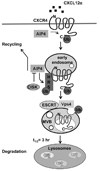The biology of CCR5 and CXCR4
- PMID: 19339947
- PMCID: PMC2718543
- DOI: 10.1097/COH.0b013e328324bbec
The biology of CCR5 and CXCR4
Abstract
Purpose of review: We discuss the current knowledge concerning the biology of CXCR4 and CCR5 and their roles in HIV-1 infection.
Recent findings: Important research findings reported in the last 2 years have advanced our knowledge in the field of HIV coreceptors and pathogenesis. Novel methods have been used to crystallize two new members of the G-protein coupled receptors. It has been demonstrated that expression and stability of the naturally occurring truncated CCR5 protein is critical for resistance to HIV-1. The first stem cell transplantation of donor cells with the CCR5 mutation provided proof of principle. The Food and Drug Administration approved the first CCR5-based entry inhibitor. New CXCL12 isoforms were discovered, one isoform is a potent X4 inhibitor with weak chemotaxis activity.
Summary: The coreceptor discoveries revealed new insights into host and viral factors influencing HIV transmission and disease. The HIV/coreceptor interaction has become a major target for the development of novel antiviral strategies to treat and prevent HIV infection. The first CCR5-based entry inhibitor has been recently approved. New drugs that promote CCR5 and CXCR4 internalization, independent of cellular signaling, might provide clinical benefits with minimum side effects.
Figures




References
-
- Alkhatib G, Berger EA. HIV coreceptors: from discovery and designation to new paradigms and promise. Eur J Med Res. 2007;12(9):375–384. Most recent review on HIV coreceptors. - PubMed
-
- Feng Y, Broder CC, Kennedy PE, Berger EA. HIV-1 entry cofactor: Functional cDNA cloning of a seven-transmembrane, G protein-coupled receptor. Science. 1996;272:872–877. - PubMed
-
- Alkhatib G, Combadiere C, Broder CC, et al. CC CKR5: a RANTES, MIP-1alpha, MIP-1beta receptor as a fusion cofactor for macrophage-tropic HIV-1. Science. 1996;272(5270):1955–1958. - PubMed
-
- Choe H, Farzan M, Sun Y, et al. The beta-chemokine receptors CCR3 and CCR5 facilitate infection by primary HIV-1 isolates. Cell. 1996;85(7):1135–1148. - PubMed
-
- Deng H, Liu R, Ellmeier W, et al. Identification of a major co-receptor for primary isolates of HIV-1 [see comments] Nature. 1996;381(6584):661–666. - PubMed
Publication types
MeSH terms
Substances
Grants and funding
LinkOut - more resources
Full Text Sources
Other Literature Sources
Research Materials

